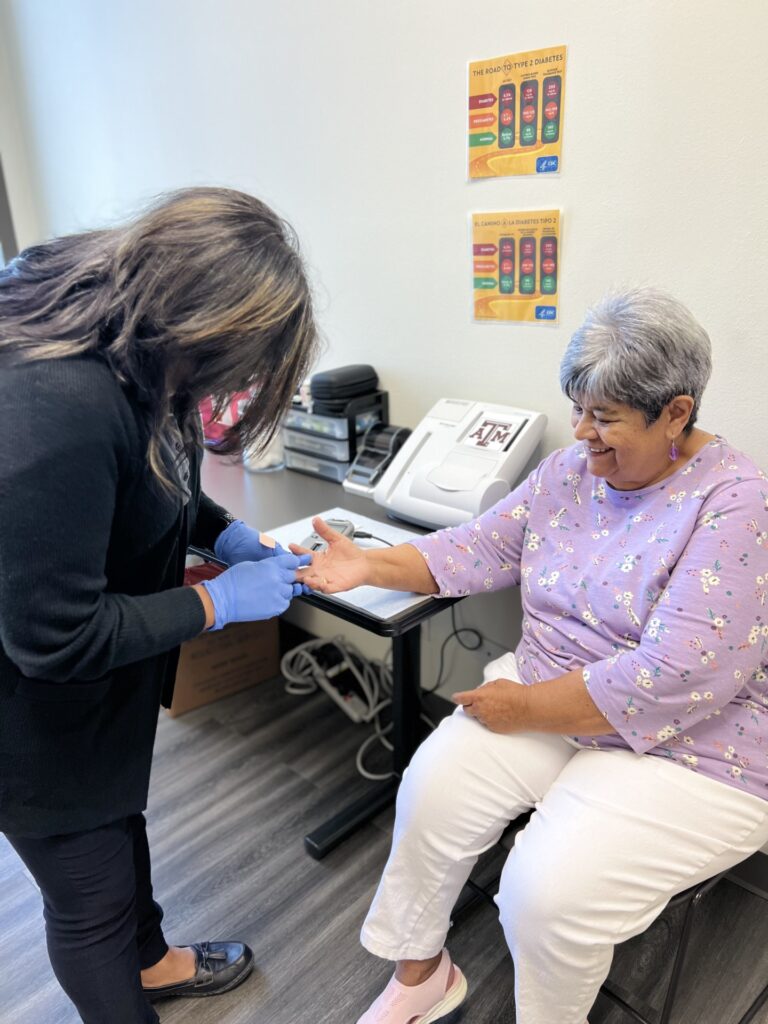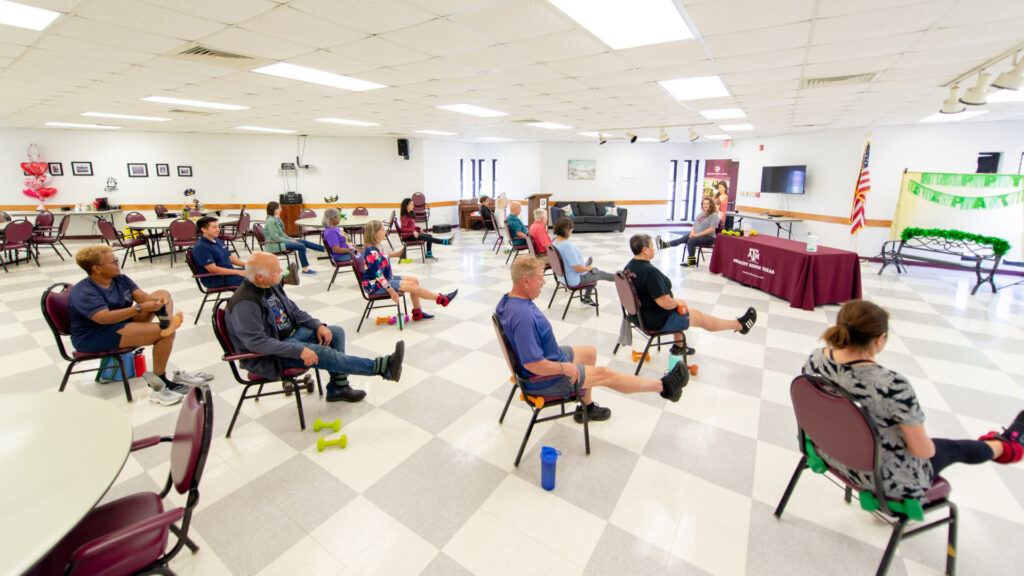Healthy South Texas tackling diabetes in multiple counties
Health initiative designed to help South Texas residents prevent, manage chronic disease
Donald D’Entremont lost 40 pounds and learned to eat healthy. Lupita Ovalle improved her energy, blood sugar and cholesterol levels. These are just two of the many individuals who have found answers for their diabetes management through the Healthy South Texas initiative.

For the past eight years, the Healthy South Texas initiative has focused on helping people prevent or manage many chronic diseases, such as diabetes, that are prominent in 27 of the state’s southernmost counties. South Texas Health System data show one in three people in the Rio Grande Valley has diabetes, with about half unaware of their condition.
Healthy South Texas combines the expertise of the Texas A&M Health Science Center with Texas A&M AgriLife Extension Service’s unique network of agents to promote preventive health at the local community level.
“Working in the 27 southernmost counties of the state, the goal of the Healthy South Texas initiative is to improve both health education and health outcomes in residents of these counties,” said AgriLife Extension’s Healthy Texas director Rusty Hohlt, Ed.D. “An area of particular interest is in the prevention of diabetes.”
Diabetes management yielding positive health results
D’Entremont, 81, of Mission, turned to Healthy South Texas for diabetes education after learning about the initiative and its Diabetes Education Program during a visit to his family doctor.

“For a lot of my life, I have been overweight,” said D’Entremont, who also has chronic obstructive pulmonary disease and kidney disease. “I have been up to 300 pounds before, but some years back, I joined a gym and got down to 180 pounds in just six months. Unfortunately, I’ve been gaining a lot of that weight back, so my doctor said I needed to get more serious about my health. That’s when she told me about Healthy South Texas and what it has to offer.”
D’Entremont’s diabetes program was delivered by Texas A&M Health at Mission Hospital, a location that collaborates with the Healthy South Texas initiative.
He said the information and materials on living a healthier lifestyle helped him lose 40 pounds and reduce his blood sugar level and A1c. He said he now buys more sugar-free items at the store and is more diligent about checking food labels for nutrition information.
“These positive lifestyle changes have not only helped me, but they have also helped my wife because we have made many of the lifestyle adjustments together,” he said. “As for me, I not only feel better physically, I also feel better mentally and emotionally.”
Ovalle, who lives in McAllen, was diagnosed with diabetes in 2021. She wasn’t sure what to do to improve her situation until she went to the American Diabetes Association website, where she learned about the Texas program.
“I called the local McAllen Texas A&M Health office and asked them to call me when they offered an in-person diabetes management class, and they did,” she said. “I didn’t know much about controlling diabetes, so attending that class gave me the information I was missing and answered all my questions.”

Ovalle, 71, said before taking the class she was overweight with high blood sugar and cholesterol levels.
“I remember that at age 65, I was tired all the time and moved slowly because my knees hurt from the extra weight I was carrying around,” she said. “I also slept too much and had no energy. I couldn’t even think about exercising.”
After going through the Diabetes Education Program and making some lifestyle changes, Ovalle said she is now at the right weight, has lowered her blood sugar and cholesterol levels and now has more energy than she had several years ago.
“Now I’m making better food choices and am more active than ever,” she said. “I take yoga classes, do stretching exercises and enjoy water aerobics. In the program, I learned how important exercise is in diabetes management, and now I exercise several times a week.”
Diabetes Education Program helps individuals take control
Anai Arenas, Texas A&M Health program coordinator for the Diabetes Education Program, McAllen, said many people who have been through the program are surprised at how quickly they begin to feel better and more energetic.
“Sometimes, when people find they have diabetes, they think it’s a ‘life sentence’ and there’s not much they can do about it,” Arenas said. “But the fact is that you have a lot of control over your own health if you’re willing to make and maintain some basic lifestyle changes.”

Ceilhy Garcia, Healthy South Texas community initiatives and evaluation coordinator for the Diabetes Education Program for Texas A&M Health McAllen, said the program gives participants supportive and effective care that allows them to “spend more time enjoying life and less time worrying about their diabetes.”
Garcia said individuals she speaks with who are newly diagnosed with prediabetes or “borderline diabetes” often think they need not worry about making lifestyle changes because they don’t yet have “serious” diabetes.
“But prediabetes means that you are at high risk of developing diabetes within the next 10 years,” she said. “At this point, with appropriate nutrition and physical lifestyle changes, you can reverse that risk.”
Healthy South Texas diabetes education
There are both in-person and virtual classes for people in South Texas and elsewhere who want to learn more about diabetes. One option is the Diabetes Education Program, a free eight-month program for adults with non-gestational diabetes or prediabetes.
The program consists of the following:
- An initial baseline screening of weight, height, A1c, fasting glucose, cholesterol and body mass index.
- One-time six-hour diabetes self-management education class, held from9 a.m.-3 p.m. on selected dates and delivered by a registered nurse, RN, or registered dietician, RD.
- Four-month follow-upscreening and RN and/or RD consultation.
- Eight-month follow-up screening and RN and/or RD consultation.
The diabetes self-management class is offered in English and Spanish and is implemented by a multidisciplinary team. Topics include understanding diabetes, how to monitor blood sugar, counting carbohydrates, reading food labels, meal planning, medication and insulin, preventing diabetes complications and exercising to manage blood glucose. More information on the program and class registration can be found at https://tx.ag/DiabetesEducation.

Another option for those interested in managing their diabetes is the Cooking Well with Diabetes program. This program is presented in communities throughout South Texas by AgriLife Extension county agents. A self-instructed version of Cooking Well with Diabetes is available on the AgriLife Learn website.
“Cooking in the home means you have more control over what you’re eating, and some of the focal points of Cooking Well with Diabetes are learning about carbohydrates, healthy fats versus non-healthy fats, and reducing sodium and increasing fiber in the diet,” said David Leal, AgriLife Extension program specialist based in Corpus Christi.
Healthy South Texas focus on chronic disease prevention
Healthy South Texas’s efforts in reducing chronic disease include educational outreach to communities on healthy food preparation and encouraging regular physical activity. They also include providing practical information and resources on chronic diseases.
Activities engage families and community partners, including hospitals and clinics, to improve the health of South Texas residents. At the same time, resources and research from Texas A&M institutions help educate families on how to lead a healthy lifestyle.

“Our multidisciplinary team empowers people of all ages to proactively manage their well-being through a range of health programs and activities,” said Starr Flores, Texas A&M Health’s regional director for Healthy South Texas. “These outreach efforts include healthy cooking classes, exercise sessions, and education promoting better nutrition choices and increased physical activity to better manage and prevent chronic diseases.”
The initiative also has a Healthy Texas Medication Assistance Program to help people who cannot afford their prescription medications or need assistance accessing health care services or resources.
Flores said Healthy South Texas will be adding two new programs:
- The CDC PreventT2 Lifestyle Change program — a yearlong program designed to prevent or delay the onset of Type 2 diabetes in people with prediabetes or who are at high risk for Type 2 diabetes.
- WELLKIDS Youth Wellness program – a program designed to help children and their families improve their overall health and quality of life and to reduce the risk factors associated with obesity and diabetes by fostering positive lifestyle changes. This program will be implemented in a hospital setting in collaboration with Driscoll Children’s Hospital in Nueces County.
Flores said Healthy South Texas efforts are supported by additional AgriLife Extension health and wellness programming, such as Walk Across Texas, StrongPeople Strong Bodies, Maintain No Gain, Step Up Scale Down and the Learn, Grow, Eat and Go! youth gardening and nutrition program.
She said from Sept. 1, 2020 to Aug. 31, 2022, more than 35,800 adult and youth program participants from the 27 counties were served by Healthy South Texas.
“Healthy South Texas efforts are improving health outcomes in their counties, which also helps reduce related medical costs for the individual and the state that amount to billions of dollars,” Flores said. “Their overall success is the direct result of compassionate, qualified staff working in collaboration with strategic community partners across our service area.”


